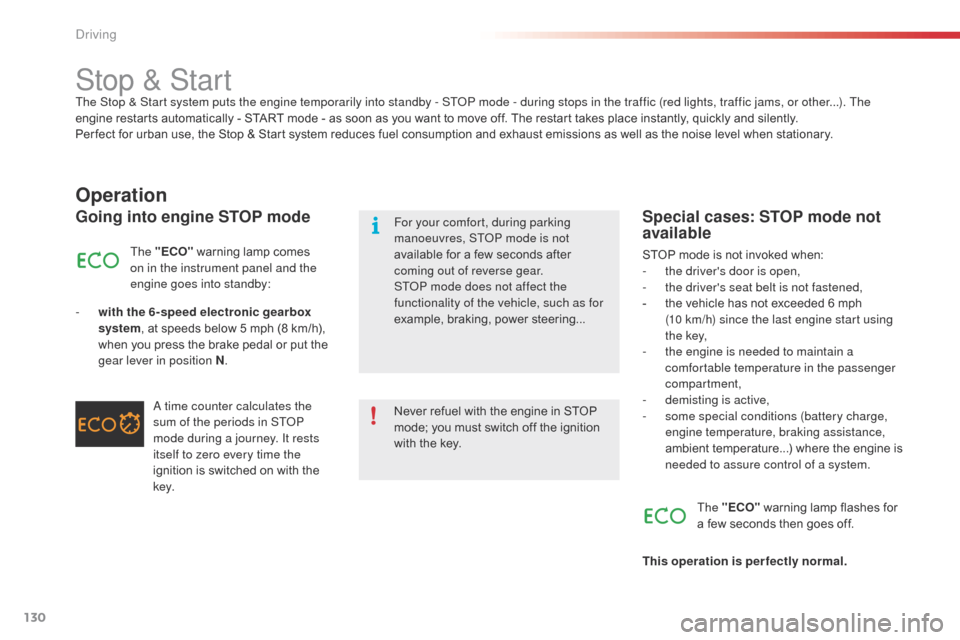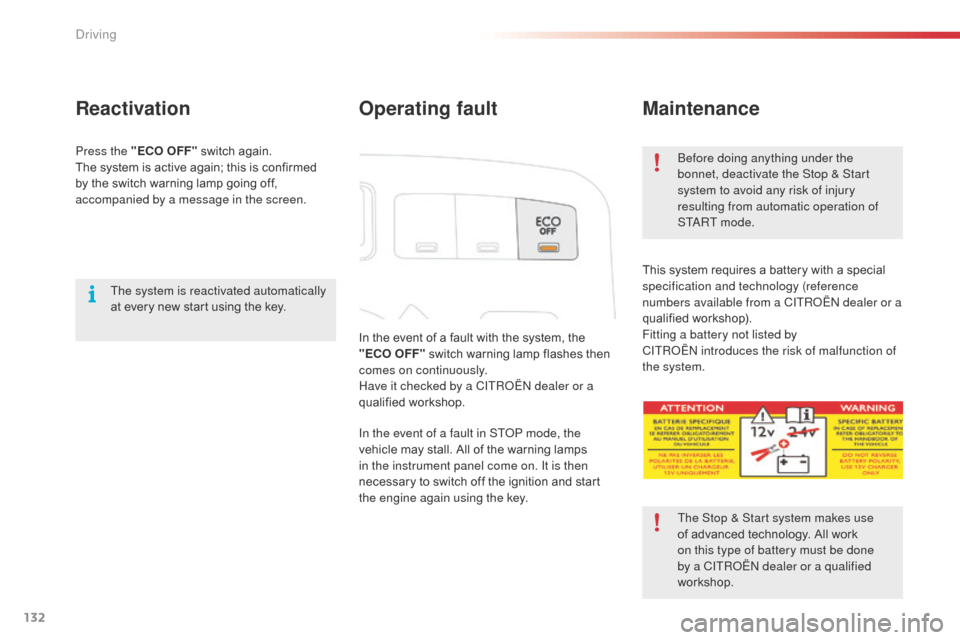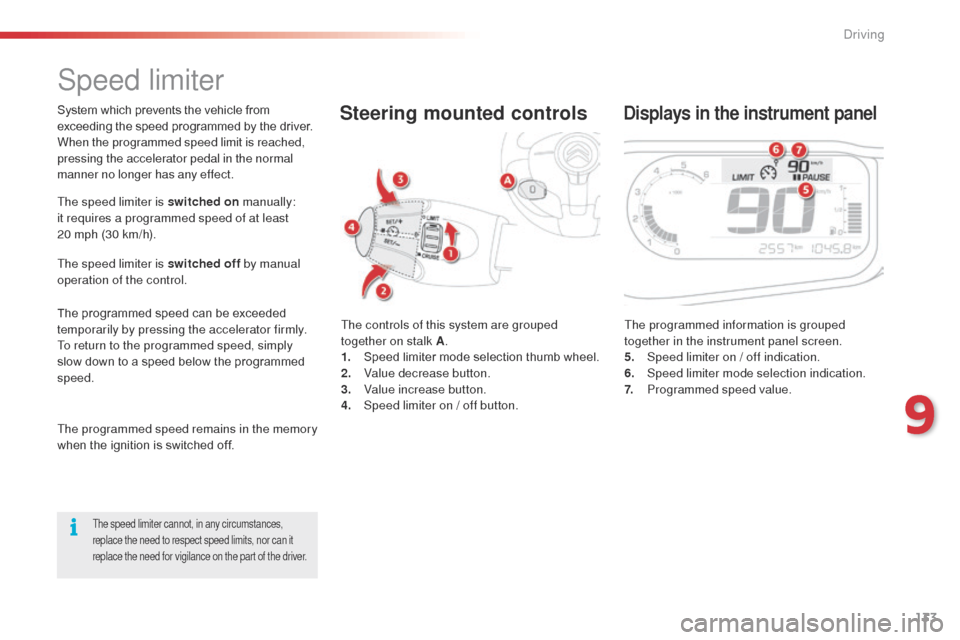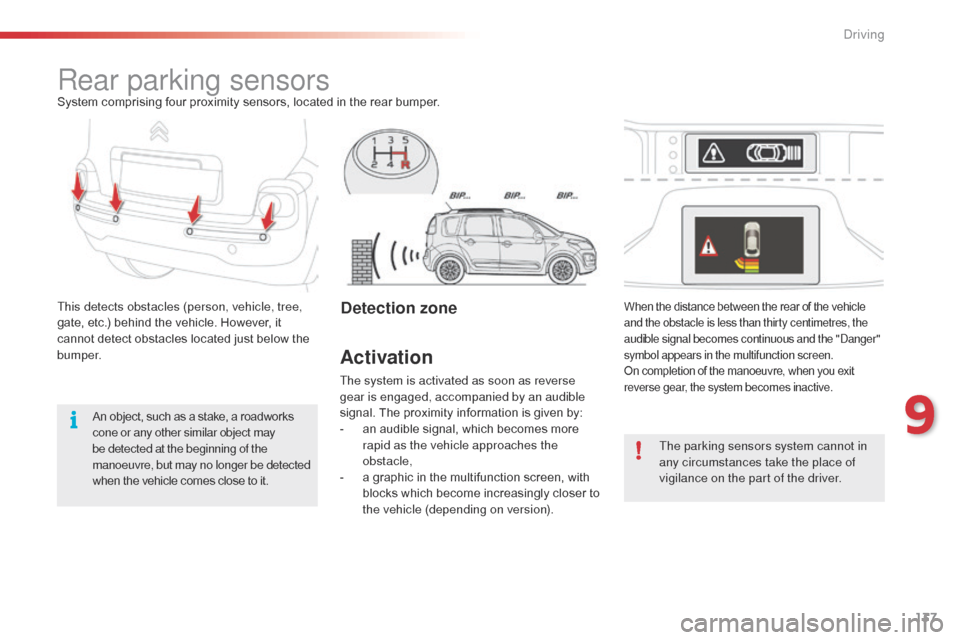Citroen C3 PICASSO 2014 1.G Owner's Manual
Manufacturer: CITROEN, Model Year: 2014, Model line: C3 PICASSO, Model: Citroen C3 PICASSO 2014 1.GPages: 292, PDF Size: 9.23 MB
Page 131 of 292

129
C3Picasso_en_Chap09_conduite_ed01-2014
Hill start assist
(with the 6-speed
electronic gearbox
sy s te m)
System which holds your vehicle temporarily
(approximately 2 seconds) when starting on a
slope, the time it takes to move your foot from
the brake pedal to the accelerator pedal.
This function is only active when:
-
t
he vehicle is completely stationary, with
your foot on the brake pedal,
-
c
ertain conditions on a slope are met,
-
w
ith the driver’s door closed.
The hill start assist function cannot be
deactivated. On an ascending slope, with the vehicle
stationary, the vehicle is held momentarily
when you release the brake pedal:
-
p
rovided you are in automated mode
(position A ) or in manual mode (position M )
on an electronic gearbox. On a descending slope, with the vehicle
stationary and reverse gear engaged, the
vehicle is held momentarily when you
release the brake pedal.
Operating fault
If a malfunction of the system occurs, these
warning lamps come on. Contact a CITROËN
dealer or a qualified workshop to have the
system checked.
Do not leave the vehicle while it is being
held in the hill start assist phase.
If you need to leave the vehicle with
the engine running, manually apply
the parking brake then ensure that the
parking brake warning lamp is on (not
flashing) in the instrument panel.
Operation
9
driving
Page 132 of 292

130
C3Picasso_en_Chap09_conduite_ed01-2014
Stop & StartThe Stop & Start system puts the engine temporarily into standby - SToP mode - during stops in the traffic (red lights, traffic jams, or other...). The
engine restarts automatically - START mode - as soon as you want to move off. The restart takes place instantly, quickly and silently.
Per fect for urban use, the Stop & Start system reduces fuel consumption and exhaust emissions as well as the noise level when stationary.
Operation
Going into engine STOP mode
The "ECO" warning lamp comes
on in the instrument panel and the
engine goes into standby:
-
w
ith the 6-speed electronic gearbox
system, at speeds below 5 mph (8 km/h),
when you press the brake pedal or put the
gear lever in position N .
a
time counter calculates the
sum of the periods in ST
oP
m
ode during a journey. It rests
itself to zero every time the
ignition is switched on with the
key.
Special cases: STOP mode not
available
STOP mode is not invoked when:
- t he driver's door is open,
-
t
he driver's seat belt is not fastened,
-
t
he vehicle has not exceeded 6 mph
(10
km/h) since the last engine start using
t h e key,
-
t
he engine is needed to maintain a
comfortable temperature in the passenger
compartment,
-
d
emisting is active,
-
s
ome special conditions (battery charge,
engine temperature, braking assistance,
ambient temperature...) where the engine is
needed to assure control of a system.
The "ECO" warning lamp flashes for
a few seconds then goes off.
This operation is perfectly normal.
Never refuel with the engine in STOP
mode; you must switch off the ignition
with the key. For your comfort, during parking
manoeuvres, ST
oP m
ode is not
available for a few seconds after
coming out of reverse gear.
ST
oP m
ode does not affect the
functionality of the vehicle, such as for
example, braking, power steering...
driving
Page 133 of 292

131
C3Picasso_en_Chap09_conduite_ed01-2014
Going into engine START mode
The "ECO" warning lamp goes
off and the engine starts with the
electronic gearbox system:
-
g
ear lever in position A or M , when you
release the brake pedal,
-
o
r gear lever in position N and the brake
pedal released, when you move the gear
lever to position A or M ,
-
o
r when you engage reverse gear.
Special cases: START invoked
automatically
For reasons of safety and for your comfort,
START mode is invoked automatically when:
-
y
ou open the driver's door,
-
y
ou unfasten the driver's seat belt,
-
t
he speed of the vehicle exceeds 7 mph
(11
km/h) with the electronic gearbox
system,
-
s
ome special conditions (battery charge,
engine temperature, braking assistance,
ambient temperature...) where the engine is
needed for control of a system.
The "ECO" warning lamp flashes for
a few seconds, then goes off.
This operation is perfectly normal.
Deactivation
at any time, press the "ECO OFF" switch to
deactivate the system.
This is confirmed by the switch warning lamp
coming on accompanied by a message in the
screen.
If the system has been deactivated
in ST
oP m
ode, the engine restarts
immediately.
9
driving
Page 134 of 292

132
C3Picasso_en_Chap09_conduite_ed01-2014
Operating fault
In the event of a fault with the system, the
"ECO OFF" switch warning lamp flashes then
comes on continuously.
Have it checked by a CITR
oËn
dealer or a
qualified workshop.
In the event of a fault in ST
oP m
ode, the
vehicle may stall. All of the warning lamps
in the instrument panel come on. It is then
necessary to switch off the ignition and start
the engine again using the key.
Maintenance
This system requires a battery with a special
specification and technology (reference
numbers available from a CITR
oËn
dealer or a
qualified workshop).
Fitting a battery not listed by
CITR
oËn
introduces the risk of malfunction of
the system.
be
fore doing anything under the
bonnet, deactivate the Stop & Start
system to avoid any risk of injury
resulting from automatic operation of
S T a
R
T m o d e .
The Stop & Start system makes use
of advanced technology. All work
on this type of battery must be done
by a CITR
oËn
dealer or a qualified
workshop.
Press the "ECO OFF" switch again.
The system is active again; this is confirmed
by the switch warning lamp going off,
accompanied by a message in the screen.
The system is reactivated automatically
at every new start using the key.
Reactivation
driving
Page 135 of 292

133
C3Picasso_en_Chap09_conduite_ed01-2014
Speed limiter
The controls of this system are grouped
together on stalk A.
1.
S
peed limiter mode selection thumb wheel.
2.
V
alue decrease button.
3.
V
alue increase button.
4.
S
peed limiter on / off button. The programmed information is grouped
together in the instrument panel screen.
5.
S
peed limiter on / off indication.
6.
Spe
ed limiter mode selection indication.
7.
P
rogrammed speed value.
Steering mounted controlsDisplays in the instrument panel
The speed limiter is switched on manually:
it requires a programmed speed of at least
20
mph (30 km/h).
The speed limiter is switched off by manual
operation of the control.
The programmed speed can be exceeded
temporarily by pressing the accelerator firmly.
To return to the programmed speed, simply
slow down to a speed below the programmed
speed.
The programmed speed remains in the memory
when the ignition is switched off.
The speed limiter cannot, in any circumstances,
replace the need to respect speed limits, nor can it
replace the need for vigilance on the part of the driver.
System which prevents the vehicle from
exceeding the speed programmed by the driver.
When the programmed speed limit is reached,
pressing the accelerator pedal in the normal
manner no longer has any effect.
9
driving
Page 136 of 292

134
C3Picasso_en_Chap09_conduite_ed01-2014
Programming
F Turn thumb wheel 1 to the "LIMIT"
position: the speed limiter mode
is selected but is not switched on
(P
a
U
S E).
You do not have to switch the speed limiter
on in order to set the speed.
Exceeding the programmed speed
Pressing the accelerator pedal to exceed the programmed speed will not have
any effect unless you press the pedal firmly past the point of resistance.
The speed limiter is deactivated temporarily and the programmed speed,
which is still displayed, flashes.
Returning to the programmed speed, by means of intentional or unintentional
deceleration of the vehicle, automatically cancels the flashing of the
programmed speed.
Leaving limiter mode
F Turn thumb wheel 1 to the "0" position: the speed limiter mode is
deselected. The display returns to the distance recorder.
Operating fault
In the event of a speed limiter fault, the speed
is cleared resulting in flashing of the dashes.
Have it checked by a CITR
oËn
dealer or a
qualified workshop.
F
S
et the speed value by pressing button 2 or 3 (e.g.: 55 mph
(90
km/h)).
You can then change the programmed speed using buttons 2 and 3 :
-
b
y + or - 1 mph (km/h) = short press,
-
b
y + or - 5 mph (km/h) = long press,
-
i
n steps of + or - 5 mph (km/h) = maintained press.
F
S
witch the speed limiter on by pressing button 4 .
F
S
witch the speed limiter off by pressing button 4 : the display
confirms that it has been switched off (PAUSE).
F
S
witch the speed limiter back on by pressing button 4 again.
on a s
teep descent or in the event of
sharp acceleration, the speed limiter
will not be able to prevent the vehicle
from exceeding the programmed speed.
To avoid any risk of jamming of the
pedals:
-
e
nsure that the mat is secured
c o r r e c t l y,
-
d
o not fit one mat on top of another.
driving
Page 137 of 292

135
C3Picasso_en_Chap09_conduite_ed01-2014
System which automatically maintains the
speed of the vehicle at the value programmed
by the driver, without any action on the
accelerator pedal.The controls of this system are grouped
together on control stalk A.The programmed information is grouped
together in the instrument panel screen.Steering mounted controlsDisplays in the instrument panel
The cruise control is switched on
manually: it
requires a minimum vehicle speed of 25 mph
(40 km/h) and the engaging of at least 4th gear.
The cruise control is switched off manually
or by pressing the brake or clutch pedal or
on triggering of the ESP system for safety
reasons.
It is possible to exceed the programmed speed
temporarily by pressing the accelerator pedal.
To return to the programmed speed, simply
release the accelerator pedal.
Switching off the ignition cancels any
programmed speed value. 1.
C
ruise control mode selection dial
2.
S
peed programming / value decrease
button
3.
S
peed programming / value increase
button
4.
C
ruise control off / resume button5.
C
ruise control off / resume indication
6.
C
ruise control mode selection indication
7.
P
rogrammed speed value
The cruise control cannot, in any circumstances,
replace the need to respect speed limits, nor can it
replace the need for vigilance on the part of the driver.
Cruise control
9
driving
Page 138 of 292

136
C3Picasso_en_Chap09_conduite_ed01-2014
Programming
F Turn dial 1 to the "CRUISE" position:
the cruise control mode is selected
but is not switched on (PAUSE).
Exceeding the programmed speed
Intentional or unintentional exceeding of the programmed speed results in
flashing of this speed in the screen.
Return to the programmed speed, by means of intentional or unintentional
deceleration of the vehicle, automatically cancels the flashing of the speed.
Return to normal driving
F Turn dial 1 to the "0" position: the cruise control mode is
deselected. The display returns to the distance recorder.
Operating fault
In the event of a cruise control malfunction,
the speed is cleared resulting in flashing of the
dashes.
Have it checked by a CITR
oËn
dealer or a
qualified workshop.
F
S
et the programmed speed by
accelerating to the required speed,
then press button 2 or 3 (e.g.: 70 mph
(110 km/h)).
F
S
witch off the cruise control by pressing button 4 :
this is confirmed in the screen (P
aU
SE).
F
S
witch the cruise control back on by pressing button 4 again.
You can then change the programmed speed using buttons 2 and 3
:
-
b
y + or - 1 mph (km/h) = short press,
-
b
y + or - 5 mph (km/h) = long press,
-
i
n steps of + or - 5 mph (km/h) = maintained press. When the cruise control is switched on,
be careful if you maintain the pressure
on one of the programmed speed
changing buttons: this may result in a
very rapid change in the speed of your
vehicle.
do n
ot use the cruise control on
slippery roads or in heavy traffic.
on a s
teep descent, the cruise control
will not be able to prevent the vehicle
from exceeding the programmed speed.
To avoid any risk of jamming of the
pedals:
-
e
nsure that the mat is secured
c o r r e c t l y,
-
n
ever fit one mat on top of another.
driving
Page 139 of 292

137
C3Picasso_en_Chap09_conduite_ed01-2014
Rear parking sensorsSystem comprising four proximity sensors, located in the rear bumper.
This detects obstacles (person, vehicle, tree,
gate, etc.) behind the vehicle. However, it
cannot detect obstacles located just below the
b u m p e r.
Activation
The system is activated as soon as reverse
gear is engaged, accompanied by an audible
signal. The proximity information is given by:
-
a
n audible signal, which becomes more
rapid as the vehicle approaches the
obstacle,
-
a g
raphic in the multifunction screen, with
blocks which become increasingly closer to
the vehicle (depending on version).
Detection zoneWhen the distance between the rear of the vehicle
and the obstacle is less than thirty centimetres, the
audible signal becomes continuous and the "
dan
ger"
symbol appears in the multifunction screen.
On completion of the manoeuvre, when you exit
reverse gear, the system becomes inactive.
An object, such as a stake, a roadworks
cone or any other similar object may
be detected at the beginning of the
manoeuvre, but may no longer be detected
when the vehicle comes close to it. The parking sensors system cannot in
any circumstances take the place of
vigilance on the part of the driver.
9
driving
Page 140 of 292

138
C3Picasso_en_Chap09_conduite_ed01-2014
DeactivationReactivation
With the engine running, press button A to
deactivate the system permanently. The
indicator lamp in the button comes on.
The system will be deactivated
automatically when towing a trailer or
when a bicycle carrier is fitted (vehicle
fitted with a towbar or bicycle carrier
recommended by CITR
oËn)
.In bad or wintry weather, ensure that
the sensors are not covered with mud,
frost or snow.
Press button A again to reactivate the system.
The indicator lamp in the button goes off.
If there is an operating fault, when reverse gear
is engaged, the service warning lamp comes
on, accompanied by an audible signal (short
beep) and a message in the multifunction
screen.
driving